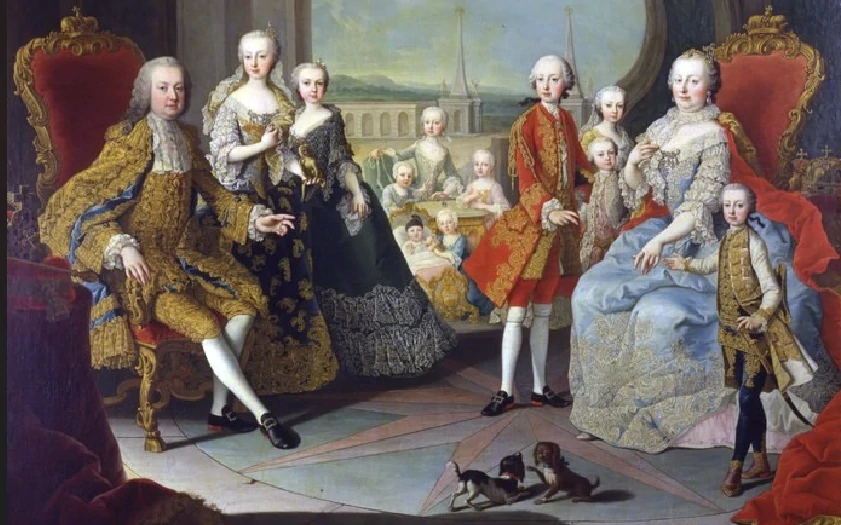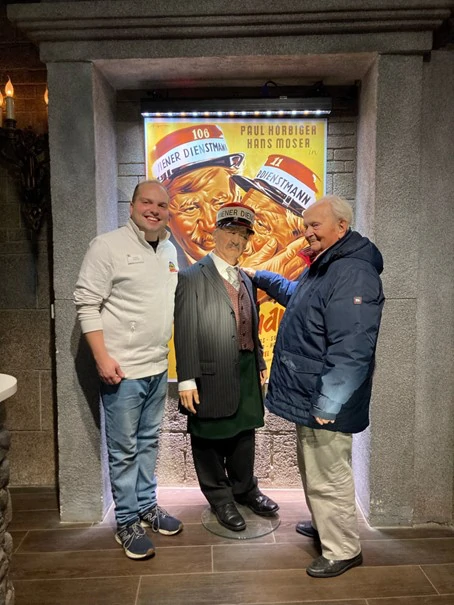At what age did Mozart give his first concert in Vienna?
Where did he perform and who did he “righteously” kiss off?
Who usually traveled with him?
Where can we find his children’s violin on display?
What happened in Vienna?
Which event changed everything?
The musical genius was born on January 27, 1756 at 8 o’clock in the evening in Salzburg at Getreidegasse 9.
The next day he was baptized in Salzburg Cathedral with the full name Joannes Chrysostomus Wolfgangus Theophilus.
However, he was called Wolferl, Wolfgang or Woferl.
He was the seventh and second surviving child of his parents Leopold Mozart, a German composer from Augsburg, and his Wife Anna-Maria Mozart, née
Pertl, from St. Gilgen am Wolfgangsee.
His older sister Maria Anna, known as “Nannerl”, was born in 1751 and died at the age of 78.
The remaining five siblings all died within the first year of their lives.
He and his sister, who was five years older, received their first piano and violin lessons at the age of four.
His father also taught the children general education.
Mozart’s childhood viol in was owned by his sister Maria-Anna for a long time and can now be seen in the Mozarthaus Salzburg.
Most recently, in April 2018, the violin was played during an Austrian state visit to the People’s Republic of China as part of a state banquet.
Mozart’s talent for playing the piano and violin was obvious and his first concert tours and performances with his sister Nannerl followed in 1762.
Munich and Passau were on the agenda, followed by Vienna.
There, the two siblings were to be presented to the imperial court.
Mozart was six years old when he and Maria Anna captivated the imperial family in the Hall of Mirrors at Schönbrunn Palace on October 13, 1762. Maria Theresa, Franz Stephan and their children were enchanted by the performance on piano and violin.
According to an anecdote, the children all played together after the concert in the Hall of Mirrors at Schönbrunn Palace.
Mozart slipped, was caught by the little Archduchess Marie-Antoinette and announced that he would marry her when he grew up.
In life, however, things always turn out differently than planned.
The words from Leopold Mozart’s letter to Salzburg about the following incident are well-known: “Wolferl jumped onto the Empress’s lap, got her around the neck and kissed her righteously”
For their performance, Wolferl and Nannerl received 100 gold ducats, 450 guilders and the precious embroidered, discarded clothes of Maria Theresa’s children.
At the time, it was customary to give the emperor’s children’s discarded dresses to their under-aunts.
What happened next in Mozart’s career?
Concert tours followed throughout Europe until he was completely exhausted.
Everyone wanted to see the child prodigy from Salzburg.
Munich, Paris, London, Brussels and Amsterdam were the first stops.
The trips to Italy from 1771-72 were particularly successful. Smallpox was rampant in Europe at the time and Mozart was also affected, as scars testify.
Back in Salzburg in 1772, Mozart was promoted to concertmaster of the Salzburg court orchestra by the new Prince Archbishop Hieronymus Franz Joseph von Colloredo.
He wanted to keep the successful musician in Salzburg, which only lasted a few years.
Mozart continued to go on concert tours and sought better employment in neighboring countries.
He auditioned in Munich and Augsburg, but did not get a job, but his stay was nevertheless fateful, as he met the Weber family and their four daughters in Munich.
He first fell in love with the eldest daughter, Aloisia, and then married the youngest, Constanze, years later.
At his father’s insistence, he traveled on to Paris in 1778, but he never found a job.
Instead, his mother, who was traveling with him, died. This was very tragic for Mozart, who was 22 years young at the time.
He traveled back to Salzburg months later, where he was appointed court organist.
This did not last long, as the free spirit Mozart was drawn away from Salzburg via Munich to Vienna.
In 1781, it was enough for the archbishop that Mozart, although officially in his service, did not return to Salzburg.
He dismissed him from his service through the count’s emissary, the prince-archbishop’s head chef Karl Joseph Maria Count Arco, who gave him the famous “kick in the foot” or, to put it more directly, the so-called “kick in the ass”.
This event kick-started Mozart’s independence as a freelance artist in Vienna.
He officially resigned from his Salzburg post and began his life in “freedom in Vienna”.
He gave piano and violin lessons and played in concerts.
The most productive and creative phase of his life now began, both privately and professionally.
On August 4, 1782, he married Constanze Weber in St. Stephen’s Cathedral.
They had six children, of whom only two sons reached adulthood.
From 1784-87, he lived with his family in the Mozart House, the only place that has survived and can still be visited.
The other 16 or so places where Mozart lived in Vienna are mostly only marked with a memorial plaque.
An excerpt from his creative period with the best-known works:
- 1782 – The Abduction from the Seraglio
- 1786 – The Marriage of Figaro – Le nozzi di Figaro
- 1787 – First performance of Don Giovanni in Prague
- 1790 – Cosi fan tutte
- 1791 – La clemenza di Tito
- 1791 – The Magic Flute
Mozart was doing very well financially during these years.
He earned well, but also spent a lot.
Some compositions were successful, some less so. His father and patron Leopold Mozart died in 1787.
Thanks to Mozart’s many letters to his father, Mozart’s life is well documented.
In the fall of 1791, Mozart fell ill with “hietzigen Frieselfieber” and was dead within a few weeks.
He died just before his 36th birthday on December 5, 1791.
A memorial plaque at the place of his death at Rauhensteingasse 8 commemorates this.
He was in the middle of working on the “Requiem”, which was completed by his pupil Franz Xaver Süßmayer.
There was much speculation about his sudden and unexpected death.
Syphilis, poisoning, the consequences of the many bloodletting sessions, etc. were suspected. Speculation continues to this day, but nothing has been proven.
Mozart was consecrated in St. Stephen’s Cathedral and buried in a common shaft grave at St. Marx cemetery.
This was in line with Joseph II’s reform of placing several people in one grave in order to save costs.
He therefore did not die impoverished, as has often been assumed.
Unfortunately, the exact spot was not marked, so today there is a monument in the middle of the St. Marx cemetery that marks the approximate location.
There is an honorary grave for Mozart in the musicians’ grove at Vienna Central Cemetery.
Mozart’s significance today?
No other composer has become as world-famous as Mozart.
When you think of a composer, Mozart is the first name that comes to mind for most people.
He is immortalized on banknotes and coins.
Who doesn’t like the delicious Mozartkugeln made from chocolate, nougat, pistachios and marzipan?
We come across him in many places in Vienna: the Mozart House, the only surviving residence in Vienna, the Mozart statue in the Burggarten, the Café Mozart.
Mozartgasse and Mozartplatz in Vienna’s Wieden district (4th district) were named after him.
In the middle of the square is the Papageno Fountain, in memory of the main character of his musical comedy “The Magic Flute”.
Mozart made it to Hollywood in 1984.
His life was made into a movie with Tom Hulce as Mozart.
Time Travel tip: At Time Travel you get a taste of Mozart’s artistic work, which you can explore in greater depth in the Mozart House, the House of Music and the Mozart Monument in the Burggarten.
Image source:
https://commons.wikimedia.org/wiki/File:Wolfgang-amadeus-mozart_1.jpg?uselang=de



